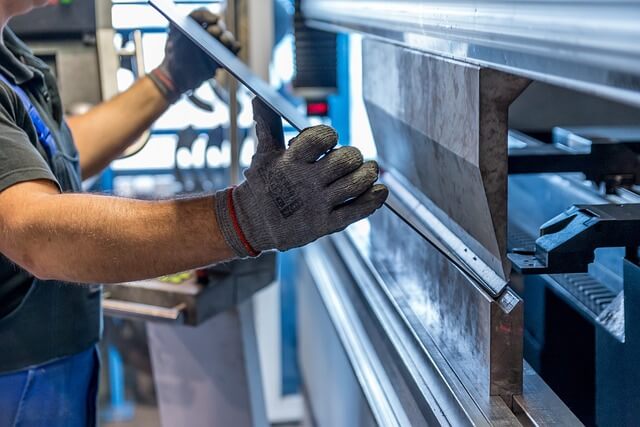Sheet metal refers to a metal shaped into thin, flat pieces using hot or cold rolling industrial processes. They’re commonly used in commercial and industrial construction due to their flexibility and resilience.
Sheet metals are lighter than timber and concrete, making them safer for constructing safe structures.
It is developed from metals like carbon steel, aluminum, copper, magnesium, stainless, and galvanized steel.
If you’re yet to determine how to use sheet metal, continue reading to learn different ways to use this material in construction.
Uses of Sheet Metals in Construction
Beams And Columns
Metal beams and columns are mainly used when constructing commercial buildings such as warehouses and factories. They’re also ideal for houses with industrial-themed interiors and exteriors.
Metal beams and columns are primarily made with galvanized tubular steel.
You can have your metal beams and columns made by a reputable sheet metal manufacturer such as Alroys Sheet Metal & Fabrication based on your preferred width, length, and tensile strength to match your building.
Sheet metal beams and columns allow quick construction since they’re ready to be bolted and assembled on-site.
It’s important to mention that steel beams and columns are excellent when building a glass house.
They provide a sleek and sharp appearance that captivates the eyes. In most cases, they’re painted black to highlight the structure’s unbending lines and edges.
Roof Trusses
Roof trusses are used to shape and maintain a roof’s structure. They’re joint frames used to support vertical, horizontal, and inclined loads. Many residential buildings have timber trusses, but things are changing, and sheet metal is quickly gaining popularity.
Roof trusses should be lightweight for the structure’s safety. This is because the structural framing and walls carry the trusses’ weight. If the trusses are heavy, the structure might collapse, especially if the framing and walls can’t withstand the weight.
That said, sheet metal might be ideal for roof truss construction compared to timber.
The most common metals used for trusses are stainless steel and aluminum since they’re durable and lightweight. Sheet metal is fabricated to develop angle bars, furring, and tubular metals.
The significance of working with competent roofing contractors cannot be overstated. As explained by roofers from The Roof Doctor skilled contractors ensure that the installation of sheet metal roof trusses is done accurately, which is crucial for the longevity and safety of the structure. They also provide valuable advice on maintenance and can help optimize the roof’s design to complement the architectural aesthetics of the building.
Structural Framing
For decades, timber has been the primary construction material for structural framing. Unfortunately, timbers are heavy and prone to insect infestation if not treated.
Fortunately, you can use something other than timber for structural framing since you can use sheet metal for similar purposes.
Currently, sheet metal is used to design bars and tubers to develop lightweight and durable structural framing. Aluminum and steel are commonly used, especially for tiny houses on wheels. Considering durability and weight, sheet metal is an excellent alternative to timber.
Besides structural framing, these metals provide excellent reinforcement for window and door framing.
Awnings And Canopies
Sheet metal is also used to create awnings and canopies. Awnings and canopies are protruding building parts that require strong reinforcement with few or no columns.
Door and window awnings protect a building’s interior against rain and sunlight. Door and window awnings made of sheet metal use tubular steel, while the roof is made of corrugated sheet metal.
Nevertheless, these awnings can be made of transparent polycarbonate sheets.
As far as canopies are concerned, their primary role is to provide shade for outdoor living spaces. Canopies’ columns are made from galvanized tubular steel to provide a stronger reinforcement.
Steel Decks And Roofs
The best thing about sheet metals is that they’re flexible; hence they can be adjusted to develop different building materials, including steel roofs and decks.
A steel deck is affordable and can be used instead of the traditional concrete slab. While it’s a cheap alternative, steel deck toughness matches that of a typical concrete slab.
It’s perfect for both commercial and residential buildings, especially when working under a tight construction framework.
Similar to steel decks, metal roofs, too, are made from corrugated sheet metal. While they’re commonly known for roofing, some property owners prefer using them as exterior siding to achieve an industrial look. Metal roofs are also used for sheds and small structure construction.
Air Ducts
Sheet metal has been and is still commonly used as air ducts. Air ducts are an aspect of the building’s heating, ventilation, and air conditioning system. They enable perfect air circulation in a building.
Air ducts are threatened by moisture and mold. Therefore, it’s important to construct them using a material that isn’t prone to mold and moisture.
That said, aluminum and galvanized steel are perfect for air ducts since they don’t encourage mold growth and moisture formation. Besides that, sheet metal is ideal for air duct construction since it’s flexible and can be bent to develop different shapes and sizes to fit different spaces.
Conclusion
Sheet metal is an ideal construction material due to its flexibility and durability. It doesn’t encourage mold growth and moisture formation; hence it’s ideal for constructing mold and moisture-free structures.
If you’re looking for a construction material that can offer unbeatable resilience, consider sheet metal for a robust and long-lasting building.
